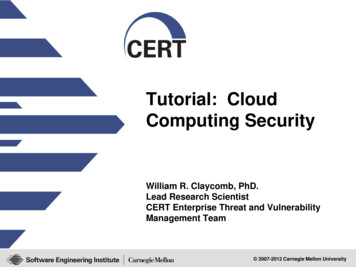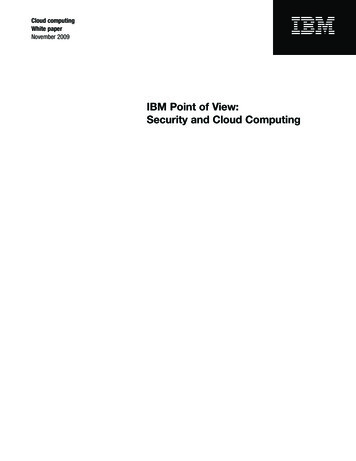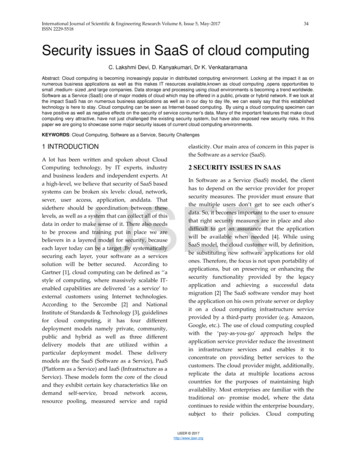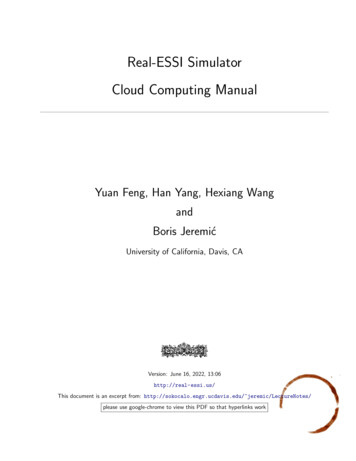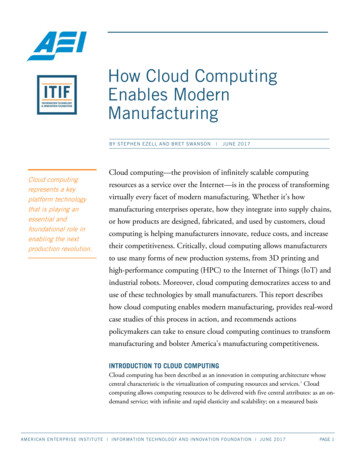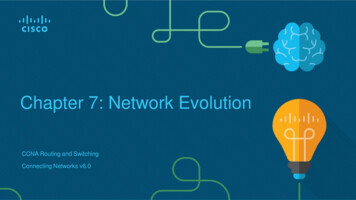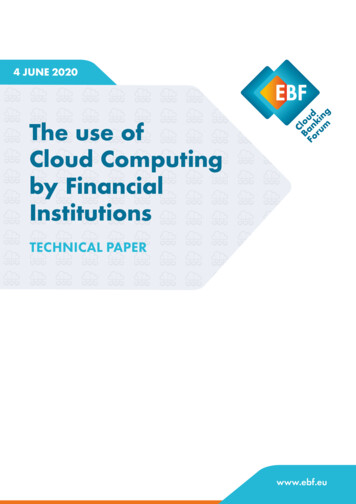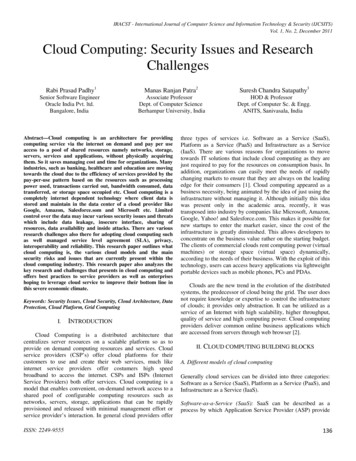
Transcription
IRACST - International Journal of Computer Science and Information Technology & Security (IJCSITS)Vol. 1, No. 2, December 2011Cloud Computing: Security Issues and ResearchChallengesRabi Prasad Padhy1Manas Ranjan Patra2Suresh Chandra Satapathy3Senior Software EngineerOracle India Pvt. ltd.Bangalore, IndiaAssociate ProfessorDept. of Computer ScienceBerhampur University, IndiaHOD & ProfessorDept. of Computer Sc. & Engg.ANITS, Sanivasala, IndiaAbstract—Cloud computing is an architecture for providingcomputing service via the internet on demand and pay per useaccess to a pool of shared resources namely networks, storage,servers, services and applications, without physically acquiringthem. So it saves managing cost and time for organizations. Manyindustries, such as banking, healthcare and education are movingtowards the cloud due to the efficiency of services provided by thepay-per-use pattern based on the resources such as processingpower used, transactions carried out, bandwidth consumed, datatransferred, or storage space occupied etc. Cloud computing is acompletely internet dependent technology where client data isstored and maintain in the data center of a cloud provider likeGoogle, Amazon, Salesforce.som and Microsoft etc. Limitedcontrol over the data may incur various security issues and threatswhich include data leakage, insecure interface, sharing ofresources, data availability and inside attacks. There are variousresearch challenges also there for adopting cloud computing suchas well managed service level agreement (SLA), privacy,interoperability and reliability. This research paper outlines whatcloud computing is, the various cloud models and the mainsecurity risks and issues that are currently present within thecloud computing industry. This research paper also analyzes thekey research and challenges that presents in cloud computing andoffers best practices to service providers as well as enterpriseshoping to leverage cloud service to improve their bottom line inthis severe economic climate.Keywords: Security Issues, Cloud Security, Cloud Architecture, DataProtection, Cloud Platform, Grid ComputingI.INTRODUCTIONCloud Computing is a distributed architecture thatcentralizes server resources on a scalable platform so as toprovide on demand computing resources and services. Cloudservice providers (CSP’s) offer cloud platforms for theircustomers to use and create their web services, much likeinternet service providers offer costumers high speedbroadband to access the internet. CSPs and ISPs (InternetService Providers) both offer services. Cloud computing is amodel that enables convenient, on-demand network access to ashared pool of configurable computing resources such asnetworks, servers, storage, applications that can be rapidlyprovisioned and released with minimal management effort orservice provider’s interaction. In general cloud providers offerISSN: 2249-9555three types of services i.e. Software as a Service (SaaS),Platform as a Service (PaaS) and Infrastructure as a Service(IaaS). There are various reasons for organizations to movetowards IT solutions that include cloud computing as they arejust required to pay for the resources on consumption basis. Inaddition, organizations can easily meet the needs of rapidlychanging markets to ensure that they are always on the leadingedge for their consumers [1]. Cloud computing appeared as abusiness necessity, being animated by the idea of just using theinfrastructure without managing it. Although initially this ideawas present only in the academic area, recently, it wastransposed into industry by companies like Microsoft, Amazon,Google, Yahoo! and Salesforce.com. This makes it possible fornew startups to enter the market easier, since the cost of theinfrastructure is greatly diminished. This allows developers toconcentrate on the business value rather on the starting budget.The clients of commercial clouds rent computing power (virtualmachines) or storage space (virtual space) dynamically,according to the needs of their business. With the exploit of thistechnology, users can access heavy applications via lightweightportable devices such as mobile phones, PCs and PDAs.Clouds are the new trend in the evolution of the distributedsystems, the predecessor of cloud being the grid. The user doesnot require knowledge or expertise to control the infrastructureof clouds; it provides only abstraction. It can be utilized as aservice of an Internet with high scalability, higher throughput,quality of service and high computing power. Cloud computingproviders deliver common online business applications whichare accessed from servers through web browser [2].II. CLOUD COMPUTING BUILDING BLOCKSA. Different models of cloud computingGenerally cloud services can be divided into three categories:Software as a Service (SaaS), Platform as a Service (PaaS), andInfrastructure as a Service (IaaS).Software-as-a-Service (SaaS): SaaS can be described as aprocess by which Application Service Provider (ASP) provide136
IRACST - International Journal of Computer Science and Information Technology & Security (IJCSITS)Vol. 1, No. 2, December 2011different software applications over the Internet. This makesthe customer to get rid of installing and operating theapplication on own computer and also eliminates thetremendous load of software maintenance; continuingoperation, safeguarding and support [3]. SaaS vendoradvertently takes responsibility for deploying and managing theIT infrastructure (servers, operating system software, databases,data center space, network access, power and cooling, etc) andprocesses (infrastructure patches/upgrades,applicationpatches/upgrades, backups, etc.) required to run and manage thefull solution. SaaS features a complete application offered as aservice on demand. Examples of SaaS includes:Salesforce.com, Google Apps.Figure 1. High Level View of Cloud Computing ArchitecturePlatform as a Service (PaaS): “PaaS is the delivery of acomputing platform and solution stack as a service withoutsoftware downloads or installation for developers, IT managersor end-users. It provides an infrastructure with a high level ofintegration in order to implement and test cloud applications.The user does not manage the infrastructure (includingnetwork, servers, operating systems and storage), but hecontrols deployed applications and, possibly, theirconfigurations. Examples of PaaS includes: Force.com, GoogleApp Engine and Microsoft Azure.Infrastructure as a Service (IaaS): Infrastructure as a service(IaaS) refers to the sharing of hardware resources for executingservices using Virtualization technology. Its main objective isto make resources such as servers, network and storage morereadily accessible by applications and operating systems. Thus,it offers basic infrastructure on-demand services and usingApplication Programming Interface (API) for interactions withhosts, switches, and routers, and the capability of adding newequipment in a simple and transparent manner. In general, theuser does not manage the underlying hardware in the cloudISSN: 2249-9555infrastructure, but he controls the operating systems, storageand deployed applications. The service provider owns theequipment and is responsible for housing, running andmaintaining it. The client typically pays on a per-use basis.Examples of IaaS includes Amazon Elastic Cloud Computing(EC2), Amazon S3, GoGrid.There are also four different cloud deployment models namelyPrivate cloud, Public cloud, Hybrid cloud and Communitycloud. Details about the models are given below.Private cloud: Private cloud can be owned or leased andmanaged by the organization or a third party and exist at onpremises or off-premises. It is more expensive and secure whencompared to public cloud. In private cloud there are noadditional security regulations, legal requirements or bandwidthlimitations that can be present in a public cloud environment,by using a private cloud, the cloud service providers and theclients have optimized control of the infrastructure andimproved security, since user’s access and the networks usedare restricted. One of the best examples of a private cloud isEucalyptus Systems [4].Public Cloud: A cloud infrastructure is provided to manycustomers and is managed by a third party and exist beyond thecompany firewall. Multiple enterprises can work on theinfrastructure provided, at the same time and users candynamically provision resources. These clouds are fully hostedand managed by the cloud provider and fully responsibilities ofinstallation, management, provisioning, and maintenance.Customers are only charged for the resources they use, sounder-utilization is eliminated. Since consumers have littlecontrol over the infrastructure, processes requiring powerfulsecurity and regulatory compliance are not always a good fit forpublic clouds. In this model, no access restrictions can beapplied and no authorization and authentication techniques canbe used. Public cloud providers such as Google or Amazonoffer an access control to their clients. Examples of a publiccloud includes Microsoft Azure, Google App Engine.Hybrid Cloud: A composition of two or more clouddeployment models, linked in a way that data transfer takesplace between them without affecting each other. These cloudswould typically be created by the enterprise and managementresponsibilities would be split between the enterprise and thecloud provider. In this model, a company can outline the goalsand needs of services [5]. A well-constructed hybrid cloud canbe useful for providing secure services such as receivingcustomer payments, as well as those that are secondary to thebusiness, such as employee payroll processing. The majordrawback to the hybrid cloud is the difficulty in effectivelycreating and governing such a solution. Services from differentsources must be obtained and provisioned as if they originatedfrom a single location, and interactions between private andpublic components can make the implementation even morecomplicated. These can be private, community or public clouds137
IRACST - International Journal of Computer Science and Information Technology & Security (IJCSITS)Vol. 1, No. 2, December 2011which are linked by a proprietary or standard technology thatprovides portability of data and applications among thecomposing clouds. An example of a Hybrid Cloud includesAmazon Web Services (AWS).Community Cloud: Infrastructure shared by severalorganizations for a shared cause and may be managed by themor a third party service provider and rarely offered cloud model.These clouds are normally based on an agreement betweenrelated business organizations such as banking or educationalorganizations. A cloud environment operating according to thismodel may exist locally or remotely. An example of aCommunity Cloud includes Facebook which is showing infigure 1.B. Cloud computing entitiesCloud providers and consumers are the two main entities in thebusiness market. But, service brokers and resellers are the twomore emerging service level entities in the Cloud world. Theseare discussed as followsCloud Providers: Includes Internet service providers,telecommunications companies, and large business processoutsourcers that provide either the media (Internet connections)or infrastructure (hosted data centers) that enable consumers toaccess cloud services. Service providers may also includesystems integrators that build and support data centers hostingprivate clouds and they offer different services (e.g., SaaS,PaaS, IaaS, and etc.) to the consumers, the service brokers orresellers [6].Cloud Service Brokers: Includes technology consultants,business professional service organizations, registered brokersand agents, and influencers that help guide consumers in theselection of cloud computing solutions. Service brokersconcentrate on the negotiation of the relationships betweenconsumers and providers without owning or managing thewhole Cloud infrastructure. Moreover, they add extra serviceson top of a Cloud provider’s infrastructure to make up theuser’s Cloud environment.Cloud Resellers: Resellers can become an important factor ofthe Cloud market when the Cloud providers will expand theirbusiness across continents. Cloud providers may choose localIT consultancy firms or resellers of their existing products toact as “resellers” for their Cloud-based products in a particularregion. Cloud Consumers: End users belong to the category ofCloud consumers. However, also Cloud service brokers andresellers can belong to this category as soon as they arecustomers of another Cloud provider, broker or reseller. In thenext section, key benefits of and possible threats and risks forCloud Computing are listed [7].III. CLOUD COMPUTING SECURITY ARCHITECTUREISSN: 2249-9555Security within cloud computing is an especially worrisomeissue because of the fact that the devices used to provideservices do not belong to the users themselves. The users haveno control of, nor any knowledge of, what could happen to theirdata. This is a great concern in cases when users have valuableand personal information stored in a cloud computing service.Users will not compromise their privacy so cloud computingservice providers must ensure that the customers’ informationis safe. This, however, is becoming increasingly challengingbecause as security developments are made, there always seemsto be someone to figure out a way to disable the security andtake advantage of user information. Some of the importantcomponents of Service Provider Layer are SLA Monitor,Metering, Accounting, Resource Provisioning, Scheduler&Dispatcher, Load Balancer, Advance Resource ReservationMonitor, and Policy Management. Some of the security issuesrelated to Service Provider Layer are Identity, Infrastructure,Privacy, Data transmission, People and Identity, Audit andCompliance, Cloud integrity and Binding Issues. Some of theimportant components of Virtual Machine Layer createsnumber of virtual machines and number of operating systemsand its monitoring. Some of the security issues related toVirtual Machine Layer are VM Sprawl, VM Escape,Infrastructure, Separation between Customers, Cloud legal andRegularity issues, Identity and Access management Some ofthe important components of Data Center (Infrastructure)Layer contains the Servers, CPU's, memory, and storage, and ishenceforth typically denoted as Infrastructure-as-a-Service(IaaS). Some of the security issues related to Data Center Layerare secure data at rest, Physical Security: Network and Server.Some organizations have been focusing on security issues inthe cloud computing. The Cloud Security Alliance is a nonprofit organization formed to promote the use of best practicesfor providing security assurance within Cloud Computing, andprovide education on the uses of Cloud Computing to helpsecure all other forms of computing. The Open SecurityArchitecture (OSA) is another organizations focusing onsecurity issues. They propose the OSA pattern, which pattern isan attempt to illustrate core cloud functions, the key roles foroversight and risk mitigation, collaboration across variousinternal organizations, and the controls that require additionalemphasis. For example, the Certification, Accreditation, andSecurity Assessments series increase in importance to ensureoversight and assurance given that the operations are being“outsourced” to another provider. System and ServicesAcquisition is crucial to ensure that acquisition of services ismanaged correctly. Contingency planning helps to ensure aclear understanding of how to respond in the event ofinterruptions to service delivery [8]. The Risk Assessmentcontrols are important to understand the risks associated withservices in a business context. National Institute of Standardand Technology (NIST), USA (http://www.nist.gov/) hasinitiated activities to promote standards for cloud computing[15]. To address the challenges and to enable cloud computing,several standards groups and industry consortia are developing138
IRACST - International Journal of Computer Science and Information Technology & Security (IJCSITS)Vol. 1, No. 2, December 2011specifications and test beds. Some of the existing standards andtest bed groups are Cloud Security Alliance (CSA), InternetEngineering Task Force (IETF), Storage Networking IndustryAssociation (SNIA) etc.On the other side, a cloud APIprovides either a functional interface or a management interface(or both). Cloud management has multiple aspects that can bestandardized for interoperability. Some possible standards areFederated security (e.g., identity) across clouds, Metadata anddata exchanges among clouds, Standardized outputs formonitoring, auditing, billing, reports and notification for cloudapplications and services, Cloud-independent representation forpolicies and governance etc., Figure 2 showing the high levelview of the cloud computing security architecture.Figure 2. High Level Security Architecture of Cloud ComputingIV. KEY SECURITY ISSUES IN CLOUD COMPUTINGCloud computing consists of applications, platforms andinfrastructure segments. Each segment performs differentoperations and offers different products for businesses andindividuals around the world. The business applicationincludes Software as a Service (SaaS), Utility Computing,Web Services, Platform as a Service (PaaS), Managed ServiceProviders (MSP), Service Commerce and Internet Integration.There are numerous security issues for cloud computing as itencompasses many technologies including networks,databases, operating systems, virtualization, resourcescheduling, transaction management, load balancing,concurrency control and memory management. Therefore,security issues for many of these systems and technologies areapplicable to cloud computing. For example, the network thatinterconnects the systems in a cloud has to be secure andmapping the virtual machines to the physical machines has tobe carried out securely. Data security involves encrypting thedata as well as ensuring that appropriate policies are enforcedfor data sharing. The given below are the various securityconcerns in a cloud computing environment. Access to Servers & ApplicationsISSN: 2249-9555 Data TransmissionVirtual Machine SecurityNetwork SecurityData SecurityData PrivacyData IntegrityData LocationData AvailabilityData SegregationSecurity Policy and CompliancePatch managementAccess to Servers & Applications: In traditional datacenters,administrative access to servers is controlled and restricted todirect or on-premise connections which is not the case of clouddata centers. In cloud computing administrative access must beconducted via the Internet, increasing exposure and risk. It isextremely important to restrict administrative access to data andmonitor this access to maintain visibility of changes in systemcontrol. Data access issue is mainly related to security policiesprovided to the users while accessing the data. In a typicalscenario, a small business organization can use a cloudprovided by some other provider for carrying out its businessprocesses. Some organization will have its own securitypolicies based on which each employee can have access to aparticular set of data. The security policies may entitle someconsiderations wherein some of the employees are not givenaccess to certain amount of data. These security policies mustbe adhered by the cloud to avoid intrusion of data byunauthorized users [9].Most companies are storing their employee information insome type of Lightweight Directory Access Protocol (LDAP)servers. In the case of SMB companies, a segment that has thehighest cloud application adoption rate, Active Directory (AD)seems to be the most popular tool for managing users. Withcloud application, the software is hosted outside of thecorporate firewall. Many times user credentials are stored in thecloud application providers databases and not as part of thecorporate IT infrastructure. This means SaaS customers mustremember to remove/disable accounts as employees leave thecompany and create/enable accounts as come onboard. Inessence, having multiple cloud application products willincrease IT management overhead. For example, cloudapplication providers can provide delegate the authenticationprocess to the customer’s internal LDAP/AD server, so thatcompanies can retain control over the management of users.Large enterprises, the management of user’s account as theadoption of single sign on (SSO) or each employee will bedispatched some different accounts to access different systems.Thus, multi-authentication for each employee might be veryoften to be confronted in an enterprise. Those accounts thatcome along with each individuals might be the same ordifferent. Therefore, how could the administrator well managethose user’s identification accounts and the corresponding139
IRACST - International Journal of Computer Science and Information Technology & Security (IJCSITS)Vol. 1, No. 2, December 2011passwords or achieve the state of SSO is another importantissue. Nevertheless, the application of SSO for identificationand authentication does have serious information security risk.In addition, the management of authorized access privilege isalso a critical key point [10].administrator on host and guest operating systems. CurrentVMMs (Virtual Machine Monitor) do not offer perfectisolation. Virtual machine monitor should be ‘root secure’,meaning that no privilege within the virtualized guestenvironment permits interference with the host system.Data Transmission: Encryption techniques are used for data intransmission. To provide the protection for data only goeswhere the customer wants it to go by using authentication andintegrity and is not modified in transmission. SSL/TLSprotocols are used here. In Cloud environment most of the datais not encrypted in the processing time. But to process data, forany application that data must be unencrypted. In a fullyhomomorphism encryption scheme advance in cryptography,which allows data to be processed without being decrypted. Toprovide the confidentiality and integrity of data-in-transmissionto and from cloud provider by using access controls likeauthorization, authentication, auditing for using resources, andensure the availability of the Internet-facing resources at cloudprovider. Man-in-the-middle attacks is cryptographic attack iscarried out when an attacker can place themselves in thecommunication’s path between the users. Here, there is thepossibility that they can interrupt and change communications.Network Security: Networks are classified into many types likeshared and non-shared, public or private, small area or largearea networks and each of them have a number of securitythreats to deal with. Problems associated with the network levelsecurity comprise of DNS attacks, Sniffer attacks, issue ofreused IP address, etc which are explained in details as follows.Virtual Machine Security: Virtualization is one of the maincomponents of a cloud. Virtual machines are dynamic i.e it canquickly be reverted to previous instances, paused and restarted,relatively easily. Ensuring that different instances running onthe same physical machine are isolated from each other is amajor task of virtualization. They can also be readily clonedand seamlessly moved between physical servers. This dynamicnature and potential for VM sprawl makes it difficult to achieveand maintain consistent security. Vulnerabilities orconfiguration errors may be unknowingly propagated. Also, itis difficult to maintain an auditable record of the security stateof a virtual machine at any given point in time. FullVirtualization and Para Virtualization are two kinds ofvirtualization in a cloud computing paradigm. In fullvirtualization, entire hardware architecture is replicatedvirtually. However, in para-virtualization, an operating systemis modified so that it can be run concurrently with otheroperating systems. VMM (Virtual Machine Monitor), is asoftware layer that abstracts the physical resources used by themultiple virtual machines. The VMM provides a virtualprocessor and other virtualized versions of system devices suchas I/O devices, storage, memory, etc. Many bugs have beenfound in all popular VMMs that allow escaping from Virtualmachine. Vulnerability in Microsoft Virtual PC and MicrosoftVirtual Server could allow a guest operating system user to runcode on the host or another guest operating system.Vulnerability was found in VMware’s shared foldersmechanism that grants users of a guest system read and writeaccess to any portion of the host’s file system including thesystem folder and other security-sensitive files. Vulnerability inXen can be exploited by “root” users of a guest domain toexecute arbitrary commands. The other issue is the control ofISSN: 2249-9555A Domain Name Server (DNS) server performs the translationof a domain name to an IP address. Since the domain names aremuch easier to remember. Hence, the DNS servers are needed.But there are cases when having called the server by name, theuser has been routed to some other evil cloud instead of the onehe asked for and hence using IP address is not always feasible.Although using DNS security measures like: Domain NameSystem Security Extensions (DNSSEC) reduces the effects ofDNS threats but still there are cases when these securitymeasures prove to be inadequate when the path between asender and a receiver gets rerouted through some evilconnection. It may happen that even after all the DNS securitymeasures are taken, still the route selected between the senderand receiver cause security problems.Sniffer attacks are launched by applications that can capturepackets flowing in a network and if the data that is beingtransferred through these packets is not encrypted, it can beread and there are chances that vital information flowing acrossthe network can be traced or captured. A sniffer program,through the NIC (Network Interface Card) ensures that thedata/traffic linked to other systems on the network also getsrecorded. It can be achieved by placing the NIC in promiscuousmode and in promiscuous mode it can track all data, flowing onthe same network. A malicious sniffing detection platformbased on ARP (address resolution protocol) and RTT (roundtrip time) can be used to detect a sniffing system running on anetwork [11].Reused IP address issue have been a big network securityconcern. When a particular user moves out of a network thenthe IP-address associated with him (earlier) is assigned to a newuser. This sometimes risks the security of the new user as thereis a certain time lag between the change of an IP address inDNS and the clearing of that address in DNS caches. Andhence, we can say that sometimes though the old IP address isbeing assigned to a new user still the chances of accessing thedata by some other user is not negligible as the address stillexists in the DNS cache and the data belonging to a particularuser may become accessible to some other user violating theprivacy of the original user [12].140
IRACST - International Journal of Computer Science and Information Technology & Security (IJCSITS)Vol. 1, No. 2, December 2011Data security: For general user, it is quite easy to find thepossible storage on the side that offers the service of cloudcomputing. To achieve the service of cloud computing, themost common utilized communication protocol is HypertextTransfer Protocol (HTTP). In order to assure the informationsecurity and data integrity, Hypertext Transfer Protocol Secure(HTTPS) and Secure Shell (SSH) are the most commonadoption. In a traditional on-premise application deploymentmodel, the sensitive data of each enterprise continues to residewithin the enterprise boundary and is subject to its physical,logical and personnel security and access control policies.However, in cloud computing, the enterprise data is storedoutside the enterprise boundary, at the Service provider end.Consequently, the service provider must adopt additionalsecurity checks to ensure data security and prevent breachesdue to security vulnerabilities in the application or throughmalicious employees. This involves the use of strongencryption techniques for data security and fine-grainedauthorization to control access to data. Cloud service providerssuch as Amazon, the Elastic Compute Cloud (EC2)administrators do not have access to customer instances andcannot log into the Guest OS. EC2 Administrators with abusiness need are required to use their individualcryptographically strong Secure Shell (SSH) keys to gainaccess to a host. All such accesses are logged and routinelyaudited. While the data at rest in Simple Storage Service (S3) isnot encrypted by default, users can encrypt their data before itis uploaded to Amazon S3, so that it is not accessed ortampered with by any unauthorized party [13].Data Privacy: The data privacy is also one of the key concernsfor Cloud computing. A privacy steering committee should alsobe created to help make decisions related to data privacy.Requirement: This will ensure that your organization isprepared to meet the data privacy demands of its customers andregulators. Data in the cloud is usually globally distributedwhich raises concerns about jurisdiction, data exposure andprivacy. Organizations stand a risk of not complying withgovernment policies as would be explained further while thecloud vendors who expose sensitive information risk legalliability. Virtual co-tenancy of sensitive and non-sensitive dataon the same host also carries its own potential risks [14].Data Integrity: Data corruption can happen at any level ofstorage and with any type of media, So Integrity monitoring isessential in cloud storage which is critical for any data center.Data integrity is easily achieved in a standalone system with asingle database. Data integrity in such a system is maintainedvia database constraints and transactions. Transaction
research challenges also there for adopting cloud computing such as well managed service level agreement (SLA), privacy, interoperability and reliability. This research paper outlines what cloud computing is, the various cloud models and the main security risks and issues that are currently present within the cloud computing industry.



